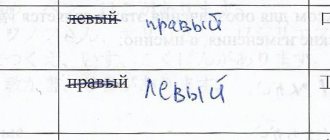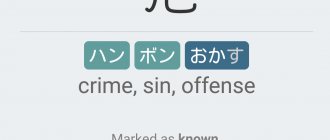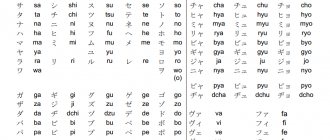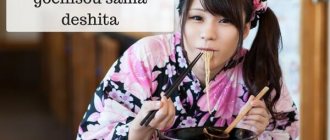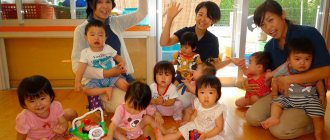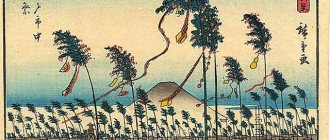Home / Japanese lessons / Hiragana
Hiragana (平仮名) is the Japanese syllabary, one of the components of Japanese writing along with katakana, hieroglyphs, Arabic numerals and Romaji (Roman alphabet). Hiragana and katakana together make up the kana system, in which one character expresses one mora. The kana sign can convey a vowel sound (for example, "a" あ); a combination of a consonant followed by a vowel (for example, “ta” た), or a nasal sonant “n” ん, which, depending on the context, can sound like Russian n, m, English ng or French nasal vowels. Hiragana is used for words that do not have kanji, including particles such as made まで and suffixes such as san さん.
Here you can:
- the entire Gojuon table of the Hiragana syllabary.
- View the order in which each syllable is written in the Hiragana alphabet.
- Download the copybook for each syllable of the Hiragana alphabet.
- Listen to the correct pronunciation.
- Read children's stories in hiragana
- Take the Hiragana knowledge test.
- New memory development game “Find the Pair” for Hiragana.
Where to begin?
If you are already familiar with all the hiragana characters, we recommend that you start by reviewing the basics. You have to find out the hiragana sign and choose the correct one from the list of answers. Proceed to the next section only if you are sure that you have a good memory of the Japanese writing characters. The tasks may seem difficult at first. Don't be afraid of mistakes! Practice regularly for 10-15 minutes a day, and within 2 weeks you will be able to achieve good results. Remember, hiragana is the basis of Japanese writing. The stronger your basic knowledge, the easier it will be for you at the first stage of studying at a language school.
| Basics of Hiragana Dakuten and Handakuten Almost all hiragana Yeon All hiragana Go to katakana |
Many thanks to Dmitry Budaragin (twitter) for the test. And also to Anton Gnatyuk for improving the test and creating new ones.
Katakana
Katakana is commonly used to write words that came to Japan from other countries. For example, the word “tennis” in Japanese does not have a hieroglyph and is written in katakana - テニス (tenisu). Here
.
Here are some more examples:
- レストラン (resutoran)
- アメリカ (amerika)
- ロシア (roshia)
- スパゲッティ (supagetti)
- カメラ (kamera)
- コンピューター (konpyuutaa)
Probably even by reading their pronunciation you already roughly understand what these words are. In its structure, katakana is most similar to hiragana. It also consists of 71 letters and is read the same way. It also has dakuten, handakuten and small tsu, ya, yu, yo. But there are also two things in katakana that are not in hiragana.
Sounds not found in Japanese
The Japanese language is very limited in the number of sounds. It’s hard for Russian speakers to imagine, but the Japanese do not use very popular sounds from the Russian language and, accordingly, pronounce them poorly. The most famous example is that the Japanese very often cannot pronounce “R” and “L” and usually pronounce some incomprehensible combination of these two sounds. Similar things happen with other sounds, but the Japanese get around by combining several different sounds that are easier for them to pronounce. The missing "v" sound is replaced with something similar to a "b". For example, ヴァ is made up of the sounds "vu" and "ya" (small) to make the sound "va", but since the Japanese have trouble pronouncing this sound, it is often heard as something between "ua" and "ba" " The absence of the "fa" sound is replaced by a combination of フ (fu) and ァ (small ya) to form "fa".
Vowel lengthening
In katakana there is a special character for lengthening a vowel - "ー". Just like the little tsu, this sound does not have its own pronunciation, but it does have its own function. The vowel that comes before this symbol becomes longer. タ (ta) when adding a stroke turns into ター (taa), マ (ma) into マー (maa) and so on.
Hiragana and script characters
Features of the table
- Spell the sign by clicking on the picture,
- Copybooks in PDF format.
| A | And | at | uh | O |
| ka | ki | ku | ke | co |
| sa | si | su | se | with |
| that | you | tsu | te | That |
| on | neither | Well | ne | But |
| Ha | hee | ugh | heh | xo |
| ma | mi | mu | meh | mo |
| I | Yu | e | ||
| ra | ri | RU | re | ro |
| va | n | o (pad.) |
(RTF, 219K) Go to katakana
Japanese alphabet Hiragana
Japanese alphabet hiragana. Click on the picture to enlarge it. If you are interested in learning Japanese, you have probably heard the word “hiragana”.
What is it? Hiragana is one of the syllabary alphabet of the Japanese language , and there are two of them. The second alphabet is called “katakana” and we will talk about it in the next article.
So, the Hiragana alphabet is used to write native Japanese words, as well as Japanese names.
Hiragana in Japanese is also used instead of kanji when it is assumed that the reader does not know any kanji. The reading of hieroglyphs is also written with hiragana signs above or below the words. For example, 大学(だいがく) /daigaku/ daigaku – “institute”. This reading of hieroglyphs is called “furigana”.
As mentioned above, the Hiragana alphabet is a syllabic alphabet, and this means that one letter or sign contains 2 sounds, i.e. a syllable.
In hiragana, as in katakana, there are also signs that contain only one sound - a vowel. This is the very first row of characters from the あ(a) sign to the お(o) sign. In the last row there are also 2 characters in which there is only one sound - this is another sign を (o). Thus, there are 2 characters in hiragana that are read as “o” - お and を.
When are these signs used? The sign お (o) from the first row is written in words, for example, おはようございます /ohayo:gozaimas(u) / ohayo:gozaimas(u) / “good morning”, and the sign を (o) from the last row of hiragana is used as grammatical particle, which is also called the indicator of the accusative case, and is never written in words. For example, ほんを よみます/ hon o yomimas(u) / hon o yomimas(u), where the word ほん/hon/hon means “book”, よみます/yomimas(u) /yomimas(u) – “read”, i.e., this phrase completely means “read (who? what? – blame. case) book.” を is not translated.
And there is another sign in which there is only one sound - this is the very last hiragana character - the sign ん / n / n.
I would also like to draw your attention to 2 signs from the 6th row of the table. They are similar and differ only in some details. This is the first character of this series - は / ha / ha and the last character of the same series - the sign ほ / ho / ho:
は - ほ
The sign は / ha / ha has one horizontal line in the upper right part, and a vertical line intersects it. The sign ほ / ho / ho has two horizontal lines in the upper right part, and the vertical line does not intersect the upper horizontal line.
In addition, as practice has shown, those starting to study hiragana very often get confused in writing the following characters, since they are very similar:
あ /a-お/o
き / ki / ki -さ / sa / sa
ぬ / nu / well-め / me / me
は / ha / ha -ほ / ho / ho -ま / ma / ma
ね / ne / ne -れ / re / re -わ / wa / wa
る / ru / ru-ろ / ro / ro
Be careful when writing these signs!
If you are just starting to learn Japanese and want to learn hiragana, katakana, and also want to learn how to write words in Japanese and construct sentences in Japanese, then sign up for free video lessons <<<here>>> .
If you already know both hiragana and katakana, did you find it difficult to remember these characters? How did you remember similar signs? Share your experience in the comments below!
This is a useful read:
- "Thank you" in Japanese: What is the difference between the phrases arigatou gozaimasu and arigatou gozaimashita.
- "I don't want" in Japanese. Japanese grammar
- Accusative case を (o)
Pronunciation rules[edit | edit code]
With minor exceptions for the particles は, を and へ, which in some cases are pronounced wa
,
o
and
e
respectively, hiragana characters are read according to the table above.
Before the Meiji reforms, pronunciation rules were more complex (see historical use of kana). Modern exceptions are a legacy of the old system. The exact pronunciation rules are called kanazukai
(仮名遣い), "the use of kana."
In hiragana, vowel length is usually expressed by adding a vowel to the previous syllable. For vowels a
,
and
,
у
the corresponding separate vowel is added:
- a (Japanese あ) - “mother” (Japanese おかあさんoka:san
), - and (Japanese い) - “Niigata” (Japanese にいがた),
- u (Japanese う) - “to eat, eat” (Japanese くうku
:).
Occasionally duplication is used for e
and
o
: “elder sister” (Japanese: ねえさん
ne:san
), “big” (Japanese: おおきい
o:kii
).
Usually the longitude “e” is indicated by adding and (Japanese い) - “order, command” (Japanese めいれいmeirei
), and “o” - by adding u (Japanese う) - “king” (Japanese おうさま
o: herself
). The vowel lengthening character chōon (ー), used in katakana, is rarely used with hiragana, for example in the word らーめん (ramen), but this use is non-standard.
A word cannot begin with kana ん ( n
), this, for example, is the basis of the game shiritori.
However, n
can be followed by a vowel.
For example, ren'ai
(恋愛, "love") is written in hiragana as れんあい (the word *
renai
れない does not exist).
Before the consonants p
,
b
and
m,
the sound
n
is pronounced as
m
, which is usually noted when transmitting Japanese text in Cyrillic.
For example, shimbun
(新聞, "newspaper") is written in hiragana as しんぶん (
shi-n-bu-n
).
Hiragana in Unicode[edit | edit code]
In Unicode, Hiragana occupies code positions U+3040 to U+309F:
| Hiragana Table from unicode.org (PDF) | ||||||||||||||||
| 0 | 1 | 2 | 3 | 4 | 5 | 6 | 7 | 8 | 9 | A | B | C | D | E | F | |
| U+304x | ぁ | あ | ぃ | い | ぅ | う | ぇ | え | ぉ | お | か | が | き | ぎ | く | |
| U+305x | ぐ | け | げ | こ | ご | さ | ざ | し | じ | す | ず | せ | ぜ | そ | ぞ | た |
| U+306x | だ | ち | ぢ | っ | つ | づ | て | で | と | ど | な | に | ぬ | ね | の | は |
| U+307x | ば | ぱ | ひ | び | ぴ | ふ | ぶ | ぷ | へ | べ | ぺ | ほ | ぼ | ぽ | ま | み |
| U+308x | む | め | も | ゃ | や | ゅ | ゆ | ょ | よ | ら | り | る | れ | ろ | ゎ | わ |
| U+309x | ゐ | ゑ | を | ん | ゔ | ゕ | ゖ | ゙ | ゚ | ゛ | ゜ | ゝ | ゞ | ゟ | ||
The Unicode hiragana block contains compound characters for all hiragana characters in use today, including reduced vowels and ё: on kanu for compound syllables, as well as the obsolete wi
and
ve
and the rarely used
wu
(ゔ).
The code table includes composite combinations of the main hiragana characters with dakuten
and
handakuten
, but they can also be obtained by placing a separate nigori or hannigori character after the main character (U+3099 and U+309A, respectively).
This method is needed to add the appropriate diacritic to kana, which is not usually used with them. For example, to add nigori to a vowel or hannigori to a syllable that does not start with x
.
The signs U+3095 and U+3096 are reduced か ( ka
) and け (
ke
), respectively.
U+309F is a double より ( yori
) character, sometimes used in vertical texts. U+309B and U+309C are the separate (not combinable with others) equivalents to the combinable characters nigori and hannigori, respectively.
Code table positions U+3040, U+3097 and U+3098 are reserved.
Hiragana alphabet[edit | edit code]
Hiragana is based on a basic set of characters, goju: it from which additional sounds can be formed. When adding a dakuten
, or
nigori
, (゛), the voiceless consonant
t is voiced
into the voiced consonant
d
, respectively
, k
goes into
g
,
s
→
dz
,
x
→
b
.
Hiragana characters beginning with x
can also be appended with a
handakuten
(゜), which changes the
x
to
p
.
There are diminished signs for the sounds i
,
yu
and
yo
(symbols ゃ, ゅ and ょ respectively).
When they are added to syllables ending in and
, their ending is replaced by a smooth palatalization.
This addition is called e: he
.
The reduced sign tsu
っ, called
sokuon
, denotes gemination (doubling) of a consonant. It occurs before fricative and stop consonants, and sometimes at the end of sentences. In Polivanov's system, this sign is displayed by doubling the subsequent consonant.
In informal writing, reduced vowel marks are sometimes used to convey a decaying sound (はぁ, ねぇ).
Some hiragana characters are rarely used. Vi signs
ゐ and
ve
ゑ have been abolished and are not used in writing.
The sign ゔ is an innovation designed to express the hard "v" sound in foreign languages, but since there is no such sound in Japanese, it is often pronounced as b
. This character is rarely used since loanwords (gairaigo) and transliterations are usually written in katakana.
Notes[edit | edit code]
- Soviet encyclopedic dictionary / Scientific ed. advice: A. M. Prokhorov (pres.). - M.: Soviet Encyclopedia, 1981. - P. 1592. - 1600 p. — 1,200,000 copies.
- Lavrentyev B.P.
Self-instruction manual of the Japanese language. — 5th ed., rev. - M.: Living Language, 2002. - S. . — 352 p. — 3050 copies. — ISBN 5-8033-0141-8. - Bjarke Frellesvig.
A history of the Japanese language. - Cambridge; New York: Cambridge University Press, 2010. - ISBN 978-0-521-65320-6. - Unicode Consortium.
The Unicode Standard 12.1 - Small Kana Extension ❰ Range: 1B130—1B16F ❱ (English).
Unicode.org
(2019). Access date: June 25, 2021. - Lenta.ru.
The oldest examples of hiragana (Russian) discovered (11/30/2012). Access date: November 30, 2012. - Song "Iroha". Translation by N. I. Conrad.
Yotsugana[edit | edit code]
Main article: Yotsugana
There are two hiragana characters pronounced ji
(じ and ぢ) and two characters pronounced as
zu
(ず and づ).
These pairs are not interchangeable. Usually ji
is written as じ, and
zu
as ず, but there are exceptions.
If in a word the first syllable is written with a sign without nigori
, and the second syllable can be written with the same sign, but with
nigori
, then the same hiragana sign is used to write them.
For example, chijimeru
(“to shed”, “to shorten”) is written as ちぢめる.
In compound words where nigori
reflects the
rendaku
, the original hiragana sign is also used.
For example, ti
(血 “blood”) is written and sounds like ち.
When the kanji 血 and 鼻 ( hana
, "nose") are combined to form the word
hanaji
(鼻血 "nosebleed"), the sound 血 changes from
ti
to
ji
.
Thus, Hanaji
is written in hiragana as はなぢ, that is, the same hiragana character is used to write the character 血.
Likewise, tsukau
(使う; "use") is written in hiragana as つかう, so
kanazukai
(かな使い; "kana use" or "kana spelling") is written in hiragana as かなづかい.
However, this rule does not apply when kanji are used to create words whose meaning cannot be learned from a literal reading of the characters. For example, the word inazuma
(稲妻, flash of lightning) consists of the kanji
ina
稲 ("rice", written as いな) and
tsuma
妻 ("wife", separately written in hiragana as つま, in a multi-kanji word as ずま
zuma
). Since its meaning cannot be directly guessed from this combination, it is usually written in hiragana as いなずま rather than いなづま.

